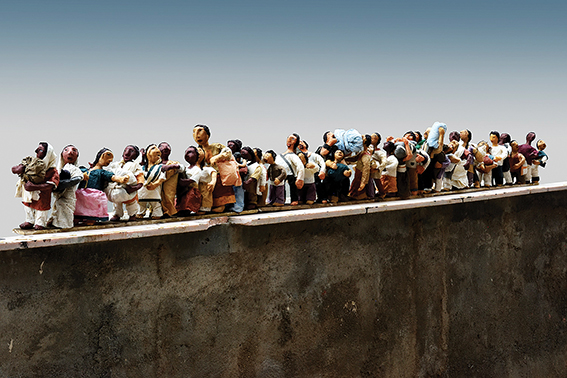
WALLS, DETENTION camps, migration, refugees – words that now predominate the current political parlance. Drawing attention to the adversities brought upon by forced displacement of people, artist Sudipta Das’s work couldn’t be any more relevant.
Referring to the devastating floods that wreaks havoc in her hometown, Silchar in Assam, Das’s work focuses on the displacement caused by climate changes. Using doll like sculptures to capture the agony, her works are on display at the exhibition titled, ‘The Exodus of Eternal Wanderers’.
Based in Baroda now, it was the floods in Gujarat last year that brought back memories of her hometown. Experiencing it in close quarters, she recalls the suffering they faced due to the overflooding of the Barak river. “During floods, the ground floor of our house would be flooded so at times we had to shift to the upper floors or move to the neighbor’s house for shelter. Our entire family would manage in one room. Most people would have to relocate from their houses.”
In 2019, when the floods hit Gujarat she observed the widespread panic as people looked for shelter and this reflects in the countless nameless figures on display.
Working on migration and land displacement for quite a few years now, Das continues on the similar track, yet looks at it from a different angle. She attempts to feature the after effects of flood, how people are displaced from one place to another, looking for temporary shelter and how these temporary shelter looks like.
Quite carefully put together, the arrangement of the exhibition adds to its narrative. For instance, take the ‘Land of Exile’ one of the installation placed right in the middle. Filled with several sculptures of people, some of whom are even right at the edge of the table, this segment has been divided into two parts. Both are placed close to one another and if one tries to walk in between them, it’s a struggle. “It is to reflect how these people grapple to shift from one place to another to reach another temporary displacement area,” explains Das.
These temporary displacement shelters of the people who have migrated have also been portrayed in the series titled, ‘Shelter I to X’.
One has to note that each of the characters on display quite aptly brings out the hurdles of the journey and appears to be life like. Scores of people walking in a line can be seen carrying their meagre belongings wrapped up in clothes and children holding hands of their parents which has also been depicted in another installation titled ‘Mother and Child’.
To create these sculptures Das has made use of the dakjee doll making technique. She had learned about this traditional technique when she was in Korea in 2017 and later developed the same in her paper sculptures.
Quite meticulously crafted from handmade Hanji paper, Das consciously choose to work with paper as a medium. “This forms my language. Since I work with old memories and history, I deal with a lot of photographs and documents. Thus, paper forms a suitable medium for me to talk about dislocation,” explains Das.
While talking about papers, one can’t help thinking about the ongoing protests that has been going on strongly in Assam against National Register of Citizens. It perhaps gives a new meaning to the exhibition.
In the course of creating her works, Das did not have the issue of NRC in her mind, however,
“as an artist our works are the reflectors of the society at various points,” she adds.
Stating that her works explores not one particular theme, she points out that the exhibition was first titled, ‘Every year the flood comes’. “My works goes beyond that as it includes migration, displacement, and hence this current title covers the multiple direction that my works tries to convey.”
For Das, migration has remained an important subject as she has grown up listening to stories from her ancestors who migrated from Bangladesh. Hence, she looks back at her personal history and family narratives to explore themes of exile, refuge and temporariness of life.
“Das’s works enable her to lend a different personality and identity to each of the figure that she creates. The works presents melancholic verse of individuals who have lost their roots, but still, for a time, have each other, raised above their homes and the places they hold dear, as if on the tide of a flood, to be deposited somewhere else. Das shows what we are doing to our fellow human beings. This is why her work is so resonant today,” says Bhavna Kakar, director of Gallery Latitude 28, who has been following Das’s practice since her days as a student in painting at Santiniketan.
As one, walks up the stairs to the gallery, the doll figures hanging from the ceiling in a line invites you to come in and join them as they embark on their tough journey.
The exhibition is on display at Gallery Latitude 28, till February 28 ■
The decline is primarily due to damage to the "heart-brain link" triggered by chronic kidney…
A French-style open-air café is drawing Delhiites back to a river they long forgot
The handset features a dual rear cameras, 6.72-inch 144Hz display, IP64 water resistance, and up…
Delhi Police raided a late-night illegal bar in Samaypur Badli, detaining 25 people and seizing…
A rear-end crash near Delhi Haat triggered a blaze that gutted both vehicles, though no…
Court grants probe agency more time as NIA pursues wider links in Red Fort blast…